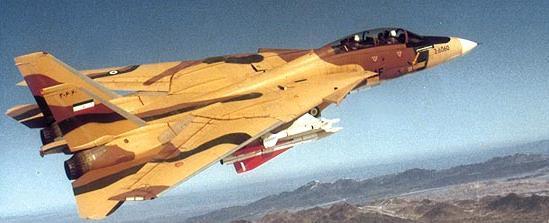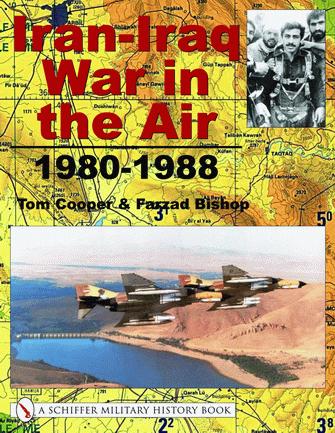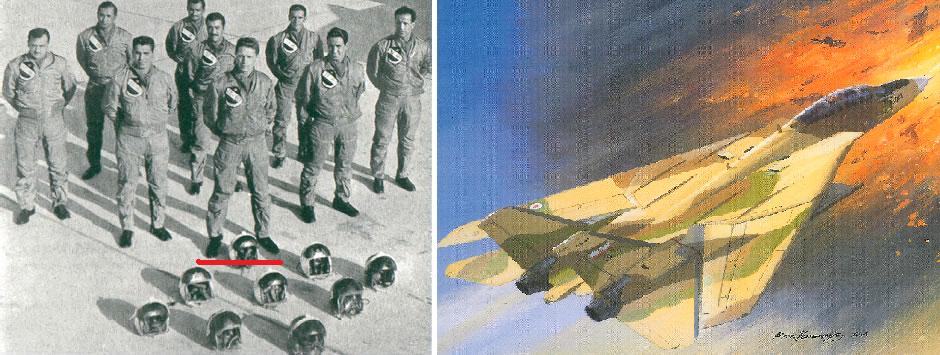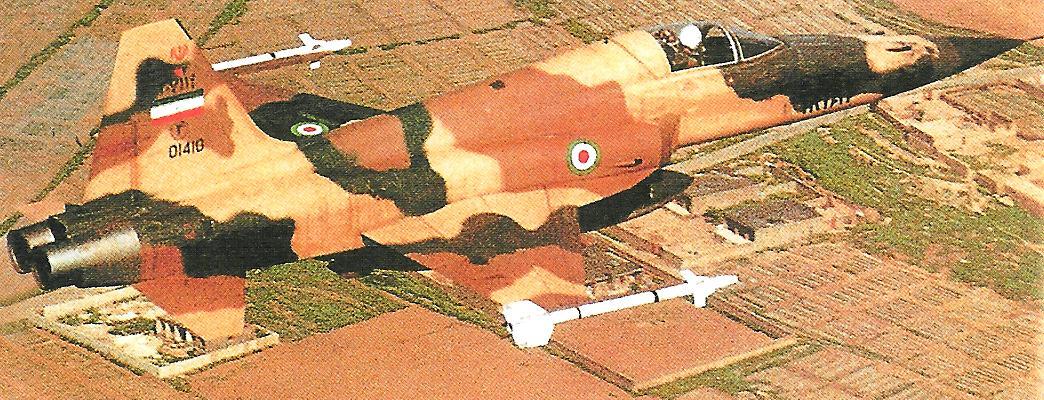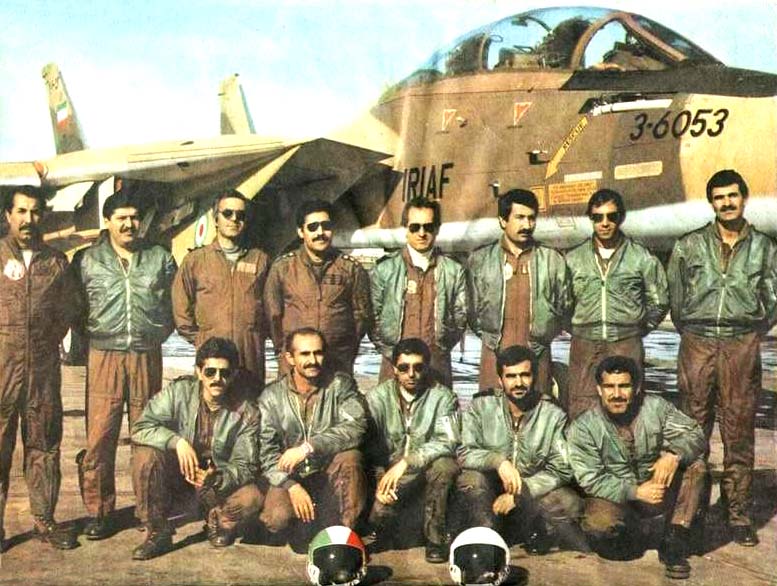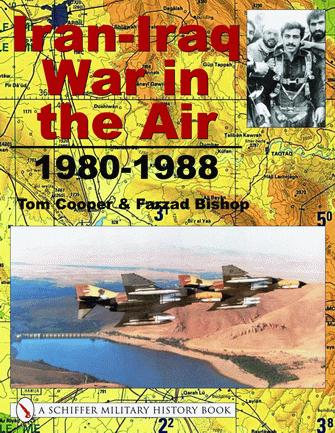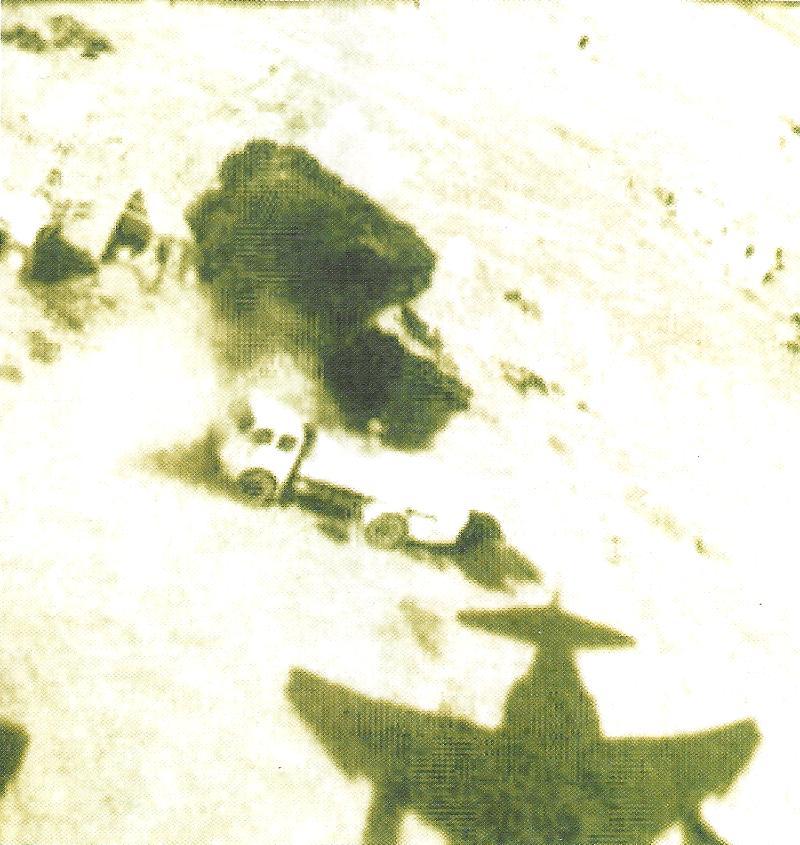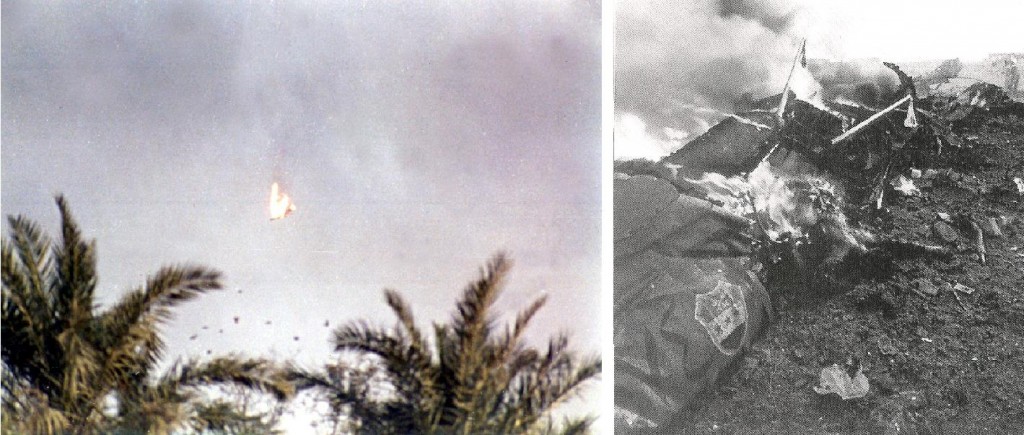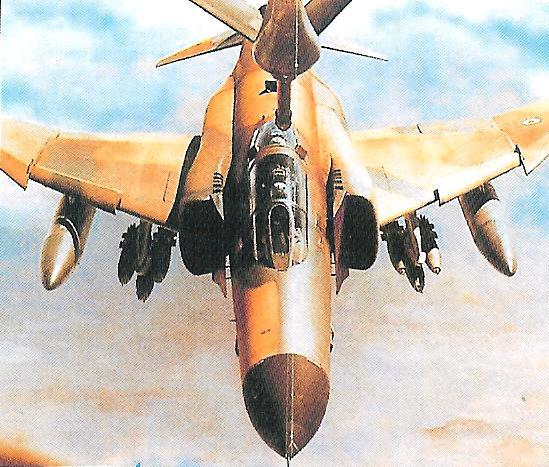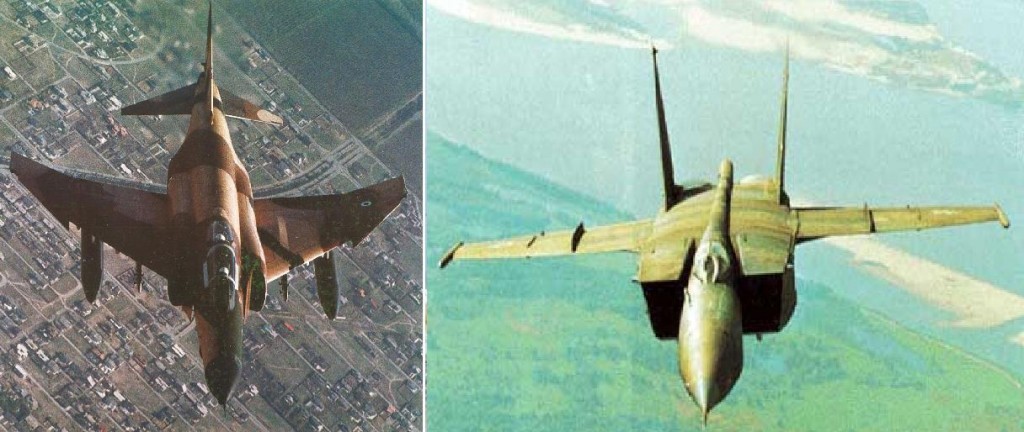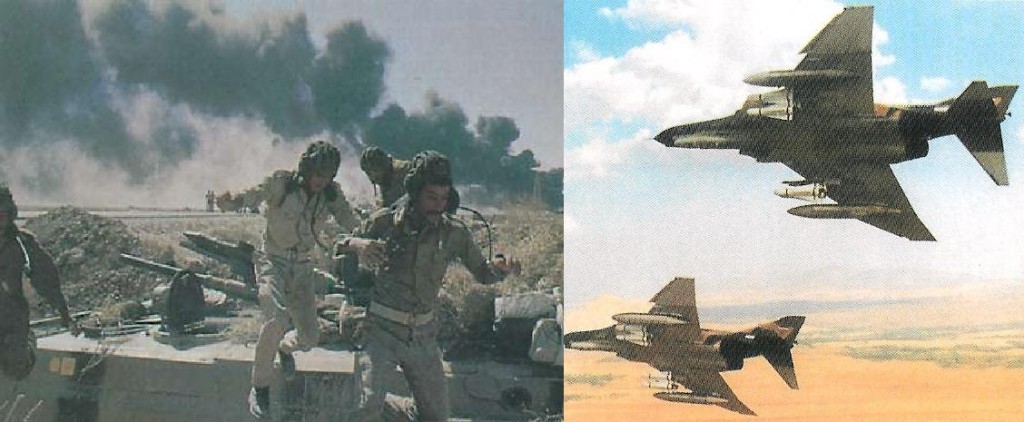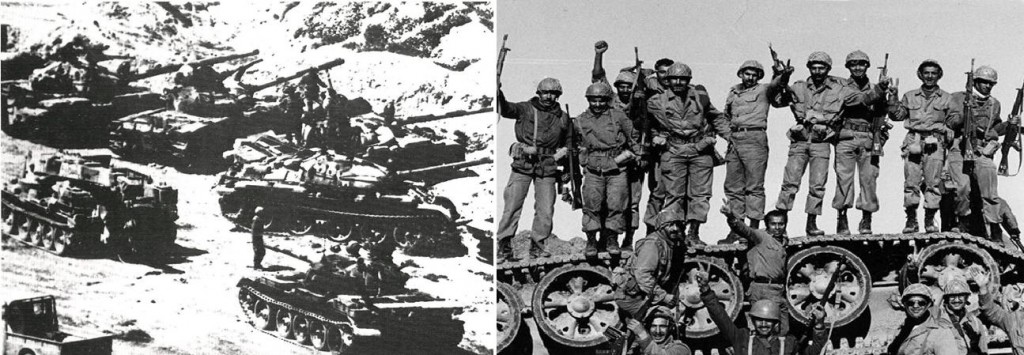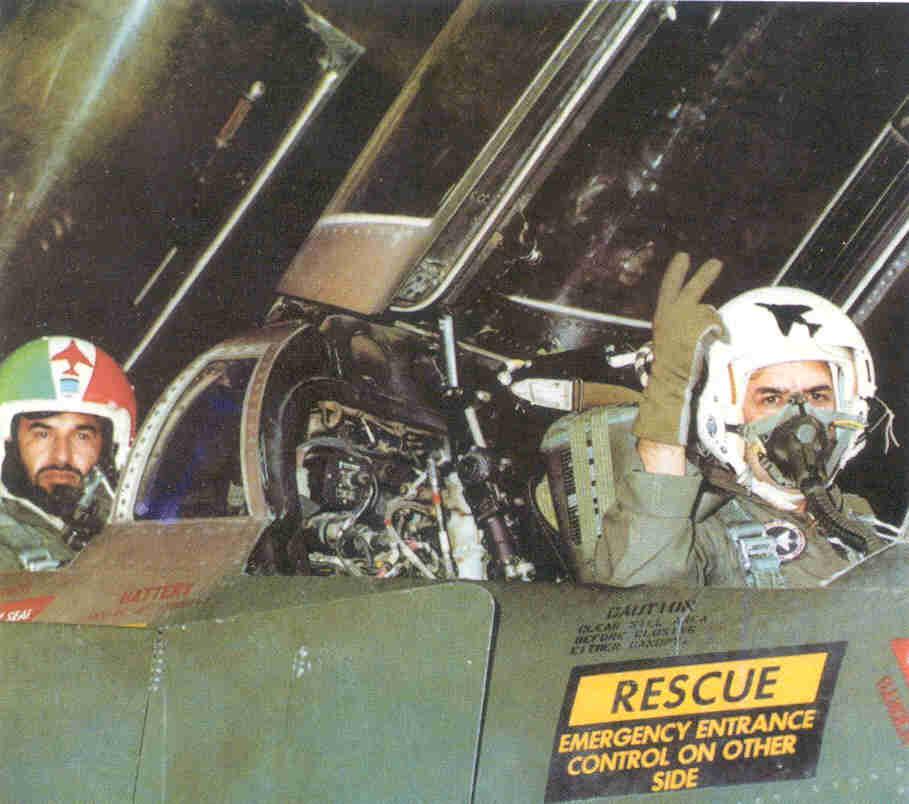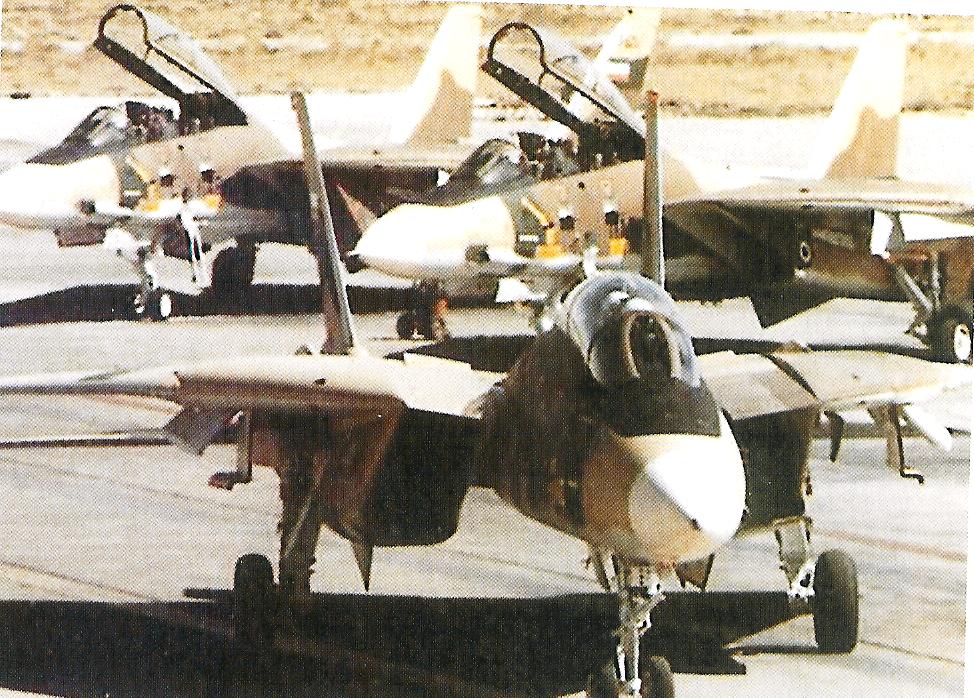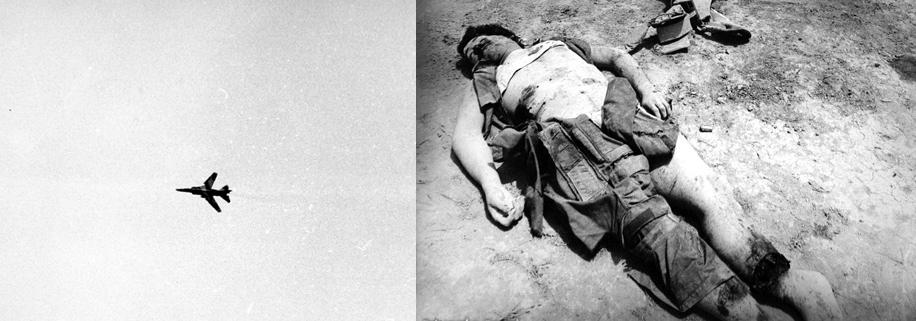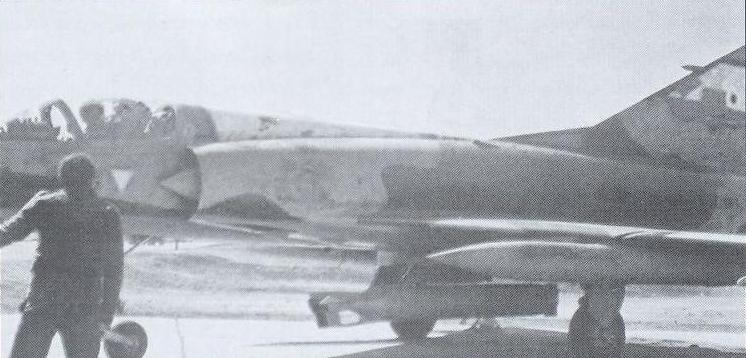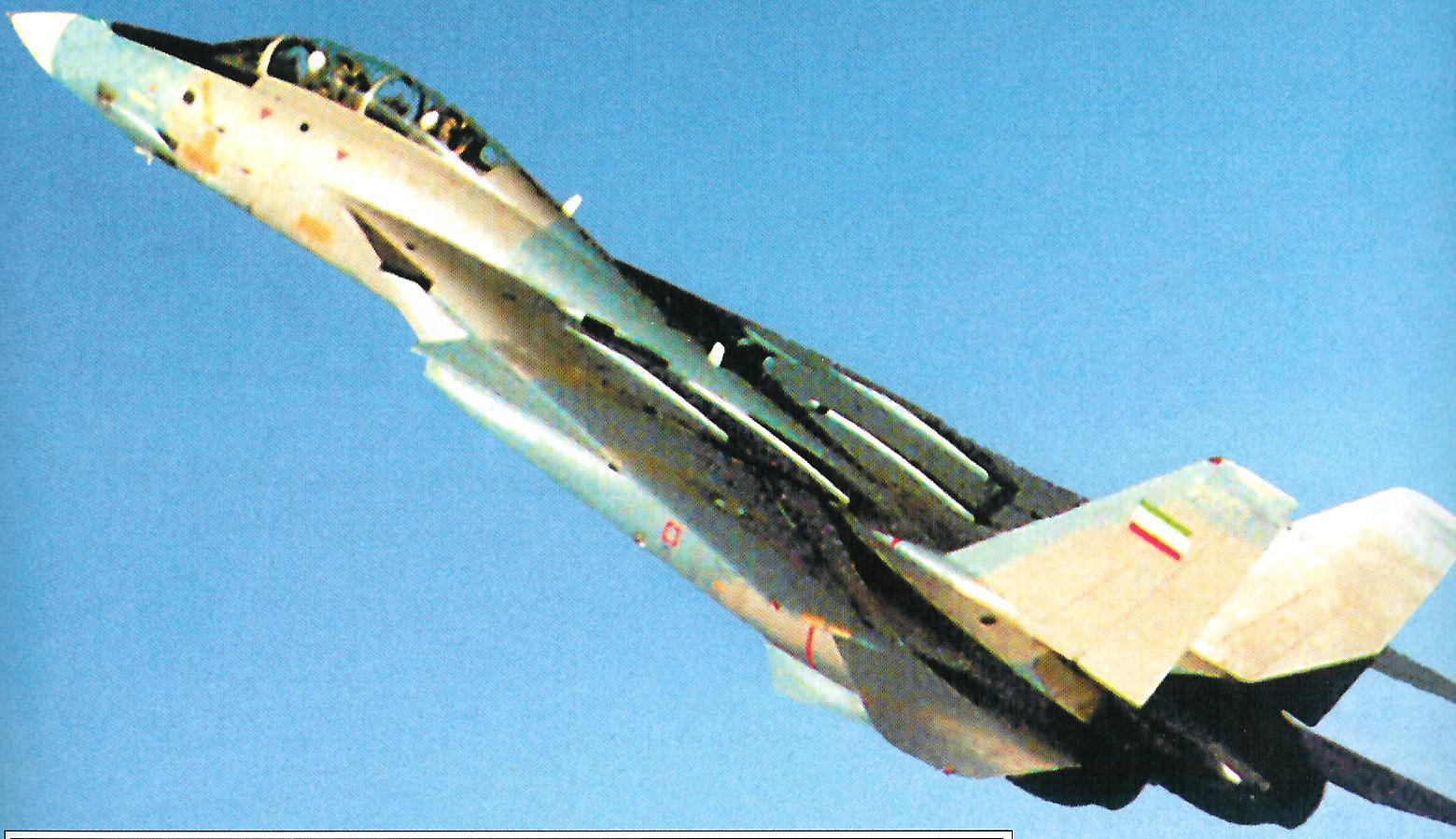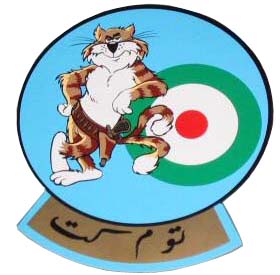Farzad Bishop and Tom Cooper have written three excellent books which have done much to dispel myths regarding the Iranian air force. Much of the history of the Iranian air force (and indeed Iranian military history since ancient times) has often been narrated by historians often propelled by Eurocentrist, Classicist and political biases.
By the late 1970s, the Iranian air force had produced an excellent cadre of top-gun pilots – these were as adept in air to air combat as they were in ground attack missions. This was in large part due to the efforts of a large pool of highly capable officers and personnel. An Iranian F-5 Tiger (Picture source: pp. 31 in “IRIAF: 75th Anniversary review”, World Air Power Journal, Volume 39 Winter 1999 issue, pp.28-37). Research by Cooper and Bishop that an F-5 fired the finishing rounds at an already damaged (by an F-14) Iraqi MiG-25 during the Iran-Iraq war. In one critical missions of the Valfajr-8 offensive (capture of Fao in 1986),, a pair of F-5s like the one above, attacked the headquarters of Iraq’s 5th Mechanized Division on March 4, 1986 (during the battle for Fao), killing the general and his entire staff (see Cooper & Bishop text “Iran-Iraq War in the Air” below). Thanks to the works of Bishop and Cooper, the daring exploits of Iran’s unknown airmen are finally coming to light. These researchers have done much to provide (at last) the real history of the Iranian air force since its inception in the early twentieth century. It must also be mentioned that widespread translation and quotation of the Cooper-Bishop works have taken place in Persian publications and weblogs in recent years. Despite being sometimes doctored and even censored – these works have triggered a massive movement not only among young Iranian aviation enthusiasts, but also among the veteran air force pilots, and the service itself, to further dig out, document and disseminate historical details pertaining to that war. It is also important to note that alongside the works of Bishop and Cooper, a whole series of independent publications have appeared in British military journals as well as first-class works in Iran that complement and further corroborate the works of Bishop and Cooper. [CLICK TO ENLARGE] Iranian pilots and crew proudly pose with their venerable Tomcat. Iranian Tomcats faced vastly superior numbers of Iraqi aircraft, many of these piloted by non-Iraqi mercenary pilots. Iranian airmen such as these proved their mettle in supporting Iranian ground and naval forces in defense of Iranian territory and the Persian Gulf. Few as yet are aware of the incredible achievements of Iranian combat aircraft (especially the F-14 Tomcat) against Soviet-designed Tu-22, MIG-21, MIG-23, MIG-25, Su-22, Su-25 and French-designed Mirage F1EQ combat aircraft (Picture source: Cooper & Bishop, 2004). The Bishop and Cooper books are not only of interest to Iranian and Western readers but also US-pilots who have flown the F-4 (Phantiom), F-5 (Tiger) and the F-14 (Tomcat). This review introduces readers to the following books produced by these authors. The first of the Bishop & Copper books to appear has been: Title: The Iran Iraq War in the Air: 1980-1988 Publisher: Atglen, PA: Shiffer Military History (200o) ISBN-10: 0764316699 ISBN-13: 978-0764316692 Order at Amazon or e-mail at [email protected] ========================= The contents of this book are as follows: ========================= Perhaps the best perspective on this valuable contribution to aviation military history is provided by Dr. Sean M. Maloney (War Studies professor at Royal Military College): In the English-language literature, the air campaigns of the Iran-Iraq War of the 1980s have received scant attention. It is common for those studying airpower to examine case studies based on the Anglo-American strategic bombing experience during the Second World War, the air war over Vietnam, Arab-Israeli experiences, or the first Gulf War of 1990-91. We now have a good window into a previously unexamined and fascinating modern air war: an American-trained-and-equipped force versus a Soviet-trained-and-equipped force fighting during the last decade of the Cold War. At right is Iraqi SU-22 pilot, Captain Mohammad Radje Suleiman who was shot down and captured by the Iranians in the Eyne Khosh region in November 7, 1982 (Picture Source: Cooper & Bishop, 2003. pp.147). At left are remains of a two-seater Iraqi SU-22 UN-3K which was forced to crash land in Iran. The type was often used to fire anti-radiation missiles against Iran’s deadly ground-based HAWK anti-aircraft system. The SU-22 airframe was part of a larger display shown at the First Iranian Grand War Exhibition held in Tehran on September 22-October 1, 2001 (Picture source: Farzad Bishop, Air Forces Monthly, 2000, pp.66). Dr. Sean M. Maloney further notes that: …the authors employ a chronological approach to the air war, and they have been careful to include the political and ground operational contexts for the air operations. Tactical helicopter, airmobile, and special operations aspects also receive recognition throughout, as do maritime air missions during the so-called Tanker War. [CLICK TO ENLARGE] An excellent gun camera view of an F-4 Phantom attack on a rear Iraqi supply unit on May 15, 1984. The Phantom is flying very low as seen by its shadow; note explosions in background. Iran often launched successful attacks with its aircraft, but these were far too few to offset Iraq’s growing military strength on the ground and in the air.(Picture Source: Farzin Nadimi, Air Forces Monthly, Classic Aircraft Series no.1, The Phantom, 2000, pp.79). Dr. Sean M. Maloney also observes that: Cooper and Bishop have come up with some fascinating angles. ….detailed examination of how the Iranian Air Force remained operational during a period of crippling American economic and military sanctions and constant bombardment by Iraq…How was it able to keep its personnel motivated under very difficult conditions? Why was Iraq unable to prevail – despite having access to Soviet resources and American intelligence? What was the nature and extent of French support to Saddam Hussein’s air force? The answers will surprise you. On the operational side, readers will learn of a daring Iranian raid on the h -2 and h -3 bases in western Iraq… [CLICK TO ENLARGE] At left is an Iraqi fighter aircraft flaming downwards at Fao in February 1986 – yet another victim of Iranian anti-aircraft defenses (Picture source: Military Photos). The Iranian HAWK missile batteries took a heavy toll of attacking Iraqi aircraft at Fao – see for example photo at left which shows an Iraqi SU-22M shot down in the Fao area on February 16, 1986. The extended rails indicate that the unfortunate pilot had tried to eject but had failed to do so – his charred body was found in the flaming cockpit. Though not recognized, Iranian combat aircraft acting in concert with HAWK anti-aircraft missiles, did much to support the Iranian success in the capture of Fao in 1986. (Picture Source: Cooper & Bishop, 2000, pp.216). Dr. Sean M. Maloney further concludes: The book is profusely illustrated. It includes Iranian Air Force reconnaissance photos and more-than-adequate maps and order of battle charts…there is enough information in the early chapters to compare the development of both air forces. There are also details of how each of the air forces was equipped in the 1970s, and how this laid the groundwork for the 1980s. Of note, there is a beginning section that examines the Shah’s covert aerial intelligence-gathering efforts against the Soviet Union during the Cold War. This book is highly recommended to anyone interested in modern air warfare. [CLICK TO ENLARGE] An Iranian Boeing 747-2J9F. Iranian pilots achieved something of a miracle with their Boeing 747s on May 9, 1982 when they transported over 6000 fully armed troops of the Khorasan’s 77th infantry division from Mashad (near the USSR-Afghanistan border in Iran’s northeast) to Khuzestan in a single night (Cooper & Bishop, 2000, pp. 134). This achievement had received little attention in the West, where the world record for this type of transport was incorrectly attributed to the Israeli airlift of 1200 Ethiopian Jews in a single night ( Picture Source: pp. 31 in “IRIAF: 75th Anniversary review”, World Air Power Journal, Volume 39 Winter 1999 issue, pp.28-37). Readers are also referred to this excellent analysis of the book provided in Iranian.com: In air to air engagements, Iran’s kill ratio was roughly 5:1, which is only surpassed by the Israelis against Syria in 1982 and the US in the Gulf war in 1991. Very often, air engagements consisted of 1-2 Iranian fighters engaging 4, or even 8 Iraqi fighters and winning. It got to the point where Iraq ordered its pilots to avoid air to air engagements (especially with the F-14), and actually had to import mercenary pilots from Egypt, and even places like Belgium, South Africa, and East Germany to fly the critical missions! [CLICK TO ENLARGE] An Iraqi Air Force Mirage F1EQ (left – picture source: Ejection History website ) and another Iraqi Mirage F1EQ which was shot down near Ahvaz on January 15, 1986 (right – picture source: Farzad Bishop) – the doomed Mirage exploded in mid-air when struck by a HAWK ground to air missile – note smoke still emanating from the wreckage. The second of the Bishop & Copper books to appear has been: Publisher: Osprey Publishing (2003) ISBN: 10: 1841766585 ISBN: 3: 978-1841766584 Order at Amazon or Osprey Publishing. ========================= The contents of this book are as follows: ========================= This book outlines the different versions of the F-4 Phantom which was the workhorse of the Iranian air force throughout the 1970s. This venerable, tough and dour fighter-bomber has seen service with an entire generation of Iranian pilots and ground crew (both before and after the revolution). Fill her Up! This F-4 Phantom is being refuelled by a Boeing 707 aerial tanker during the Iran-Iraq war. Iranian jets often refuelled before going into combat missions inside Iraq. This particular Phantom is equipped with six Mk-82 bombs (equipped with Snakeye retarding fins). These allowed the Phantoms to attack ground targets at low-level and high-speed (Picture Source: Bishop & Cooper, 2003. colour picture 5). The Phantom was indeed the workhorse of the Iranian air force during the 8-year Iran-Iraq war. Iranian F-4 Phantom IIs in particular were some of best equipped models exported by the US. Some Iranian Phantom II pilots accumulated massive combat experience with this aircraft, some flying this in combat for ten-plus years! However, the Phantom II had already experienced combat even before the onset of the Iran-Iraq war. Iranian Phantoms flew alongside British Hunters during operations against Communist rebels in Oman in the 1970s. However the Phantom was also critical for defending Iranian airspace and territory. [CLICK TO ENLARGE] Cold War encounter: Iranian F-4 Phantom in flight over Northern Iran (left) and a high-performance Soviet Air Force MIG-25 Foxbat interceptor (right). By the late 1970s Iranian pilots were approaching NATO levels of effectiveness. This was demonstrated by a Phantom II which shot down a highly advanced Soviet Air Force MIG-25 Foxbat which had entered Iranian airspace in 1977 (the stricken Soviet aircraft reportedly crashed inside the Soviet Union as it attempted to flee Iran). The rising abilities of Iranian pilots were duly noted in a USAF-Hughes Aircraft Company report. In one incident in June 1975, Iraqi tanks invaded Iran’s Khuzestan province in June 16, 1975. Iranian F-4E Phantoms wiped out an entire Iraqi tank column in 20 minutes – none of the Iranian F-4Es were lost. The Iraqi invasion force was then rapidly thrown back for just 3 Iranian casualties (for more information see Copper & Bishop, 2000, pp. 62 and Iran at War: 1500-1988, 2011, pp. 316-317). [CLICK TO ENLARGE] -Tayyara! Tayyara! (Arabic: Airplane! Airplane!). Iraqi crew of a BMP armored peronnel carrier advancing in Iran in 1980 (at left) abandon their vehicle in haste at the sound of the roaring engines of two US-made Iranian F-4E Phantoms. Iranian Phantoms (at right) were also reported to be flying just meters above ground level to fire their 20mm cannon at Iraqi tanks and armored vehicles (Picture Source at left: www.Acig.org; Picture Source at right: Farzad Bishop, Combat Aircraft 37, reproduced with permission in Iran at War: 1500-1988, 2011). Iranian pilots repeatedlyexhibited their deadly skills throughout the Iran-Iraq war of 1980-1988. It was during the liberation of Khuzestan province in March-May 1982 when up to 95 F-4 and F-5 fighter aircraft virtually annihilated the Iraqi 12th armored division in a single operation (for more information see Iran at War: 1500-1988, 2011, pp. 363-364). Such feats set Iranian pilots on par with the world’s best. [CLICK TO ENLARGE] –Elements of the Iraqi 12th Armored Division assemble at Fakkeh (in the Dezful area) on March 23rd 1982 to rescue remnants of the Iraqi 4th Army Corps crushed by a powerful Iranian offensive (Left – Steven J. Zaloga, Modern Soviet Combat Tanks, Osprey Vanguard 37, pp.32). As these units deployed to attack, they were bombed and strafed by up to 95 Iranian F-4 and F-5 combat aircraft. The Iraqi 12th Armored Division was virtually eliminated. At right are Iranian regular army troops atop an overturned Iraqi tank of the 12th armored division (source: www.shahed.isaar.ir). Note that the vehicle has been blown upside down as a result of aerial bombardment by Iranian F-4 and F-5 combat aircraft. Bishop and Cooper’s excellent text on Iranian Phantoms has finally removed the “info blackout” with respect to Iranian Phantom II missions before and during the Iran-Iraq war. [CLICK TO ENLARGE] An F-4E lands after the conclusion of a successful mission during the Iran-Iraq war (date unknown). At the back-seat is war hero Lieutenant-General Abbas Babaie, who was at the time deputy-commander of the Iranian air force. Babaie also flew combat missions before finally being reportedly killed by Iraqi anti-aircraft fire (Picture Source: 2000, Air Forces Monthly Special: Classic Aircraft Series Number 1, “Combat over Iraq”). The third of the Bishop & Copper books to appear has been: Publisher: Osprey Publishing (2004) ISBN:10: 1841767875 ISBN: 13: 978-1841767871 Order at Amazon or Osprey Publishing. =========================== The contents of this book are: =========================== Before the overthrow of the Pahlavi establishment in 1979, the Iranian air force had ordered 80 F-14A Tomcats (79 were delivered before the revolution). Along with the Tomcats came the lethal AIM-54 Phoenix missiles. [CLICK TO ENLARGE] Freshly delivered F-14 Tomcats at the Iranian airbase of Khatami before the revolution (Cooper & Bishop, 2004, Color plate 3). Despite the massive disruptions wrought upon the air force in the aftermath of the revolution (i.e. purges, imprisonment, etc) Iran’s pilots were to achieve incredible feats in air to air combat in 1980-1988. The new leadership acquiesced to the reality that these ‘Top Gun” pilots were a vital element for Iran’s survival. [CLICK TO ENLARGE] Iran’s Sattar-1 laser-guided air-to-ground missile designed after the Iran-Iraq war. This is believed to have borrowed some features from the Phoenix air to air missile. The Phoenix downed large numbers of Iraqi air force aircraft during the Iran-Iraq war, including those flown by mercenary pilots (Picture source: The Arkenstone). Though just beginning to be acknowledged, the Iranian pilots and ground crews demonstrated an unprecedented level of skill, which in combination with an ancient and deeply ingrained sense of national identity, allowed Iran to defend its airspace against seemingly impossible odds, right up to the ceasefire of August 1988. In one of the interviews conducted by Kaveh Farrokh for the recent text, Iran at War: 1500-1988, a veteran of the Iranian air Force named (“Ghahreman“) noted to the author that: When the Iraqis invaded in 1980 a young colonel arrived at the Vahdati airbase… he bluntly told us ‘Gentlemen…today Iranzamin is theatened as it has been so many times in its ancient history…do not despair as you enter combat …you are the sons of Cyrus, Khosrow, and Rustam of Iran Bastan [ancient Persia] … This speech is reminiscent of the tribute given by British Prime Minister Winston Churchill to the British RAF’s exploits against the German Luftwaffe in 1940 – Churchill declared: “Never in history has so much been owed by so many to so few“. The pilots of the Iranian F-14s, F-4s and F-5s certainly deserve the same level of professional praise as that bestowed upon other world-class air fleets such as the RAF. An Iranian F-14 Tomcat shows off a modified HAWK missile. The integration of the huge surface-to-air Hawk missile into the F-14 weapon system as an air-to-air missile was a surprising feat of ingenuity. When the pictures of Iranian Tomcats carrying the HAWK were released for the first time, most Western media had been claiming for years that Iran’s F-14 fleet was grounded due to lack of spare parts and qualified technicians to maintain them. Those pictures showed that the Iranians had become very good at reverse engineering Western systems without any assistance, to the point that they not only could keep the Tomcats airworthy. This also shows that the iranians are capable of coming up with Indigenous and imaginative solutions in order to use all weapons in their arsenal. (Picture source: Mehr News). Interestingly, the exploits of Iranian F-14 Tomcats remain largely unknown. There are numerous false narratives about the Iranian Tomcats during the Iran-Iraq such as claims that that the Iranians were incapable of firing their Phoenix missiles (i.e. Sreedhar, 1985, pp. 127) or Western authors (.e. Peacock, 1986, pp.43, F-14 Tomcat, Osprey Publishing) repeating the Baathist-regime propaganda that Iraqi jets had downed as many as 70 Tomcats. Bishop and Cooper reveal that nearly all of these Baathist-based Western reports are overwhelmingly false. Detailed post-war studies also based on Bishop and Cooper’s studies have been published in British military journals which question and revise claims such as those made by Peacock and Sridhar. Below are a number of excerpts by various editions of the British Air Forces Monthly journal: “Despite many reports to the contrary, the type [F-14A] was instrumental in defending Iranian air space…it used all its weapons to near perfection shooting down any type of combat aircraft in the Iraqi inventory…(2002, 177, pp.30)…the Tomcat shot down at least 95 Iraqi combat aircraft, at least thirty of which were confirmed as AIM-54A Phoenix kills…seven and ten more were listed as probable kills… (2002, 169, pp.64)” The World Air Power Journal reported that during the Iran-Iraq war: “…the presence of one or two Tomcats was usually enough to send the Iraqi jets scurrying away. Only one Iranian Tomcat was confirmed as shot down in air to air combat during eight years of war…” (1999, pp. 32; see also report by Noush in Aircraft Illustrated, 1999). Although research conducted by Cooper and Bishop so far show only one Tomcat loss can be positively attributed to air-to-air causes, however, newly surfaced data suggest probably more F-14s were lost to Iraqi aircraft. For further details click this link in ACIG… WARNING-GRAPHIC PHOTO -[CLICK TO ENLARGE] An Iraqi Mig-23 just before it was shot down by Iranian forces (left) and the remains of its unfortunate pilot after the plane crashed (right) (Picture sources: Military Photos Net). Iraqi Mig-23 aircraft suffered heavy losses at the hands of Iranian F-14s – despite much Soviet-East Bloc, French-Western, and some Indian assistance, right up to the last days of the war (Picture Source: AviationLive.org). As documented by Cooper and Bishop, Iranian F-14s downed large numberss of Iraqi Migs, Sukhoi, Tupolev and Mirage III fighters. In practice, the Iranian pilots would sometimes “rotate” by flying different aircraft types during the war. What must be appreciated is the fact that some of the Iraqi jets, especially after 1983, were reportedly piloted by mercenary pilots of Russian, East German, Belgian, Egyptian, and probably even French pilots. Belgian pilot Max von Rosen for exanple, reportedly planned or even led a number of air raids against the Iranian Kharq Island oil terminal. Cooper and Bishop also noted to Kavehfarrokh.com on Sept. 12, 2011 the following: …few Western mercenaries, a few French pilots seconded via the AMD, some Soviets on exchange tours, and few Egyptians flew with the Iraqi air force. The Indians were there from 1960s until 1980, and again in the 1983-86 period – but only as trainers assigned to IrAF training units. The Flying Pharaohs: An Egyptian Mirage 5-SDE on an Iraqi airfield partaking in special combat (electronic warfare) operations against Iranian forces at Fao in 1986. Note that the Egyptian markings have been removed (Picture Source: Cooper & Bishop, 2003, pp.243). The daring exploits of Iranian Tomcat pilots and their ground crew almost defy imagination and are a must-read for US Navy pilots who also used to fly the Tomcat. An Iraqi air force Su-25 (left – Picture source: Iran Defense Net – original owner of photo is Christopher Foss) and a Su-22M shot down near Baneh in northwest Iran on October 16, 1987 (right – picture source: Farzad Bishop). The doomed Sukhoi was first targeted for termination by an Iranian Tomcat forcing the Iraqi jet to dive extremely low – the Su-22 did this to avoid being blasted by the Tomcat’s Phoenix missile. This only led the doomed jet into the sights of Iranian 35mm anti-aircraft guns which shot down the aircraft. There are numerous other dramatic cases reported by Bishop and Cooper. One of these was the very lucky escape of Iraqi Generals Abdul Jabbar Mohsen and General Maher Abdul Rasheed of the Iraqi Fourth and Third Army Corps respectively. The Generals had boarded a Mi-8 helicopter on November 20, 1982 to fly towards Iraq’s front lines. Two Mi-8s and eight fighter aircraft (four MIG-21s and four MIG-23s) provided escort for the VIP helicopter. What occurred next proved to be one of the most dramatic incidents of the entire Iran-Iraq war. An Iranian Tomcat appeared and fired its deadly Phoenix and Sidewinder missiles into the Iraqi aircraft. Two MIG-23s and one MIG-21 plunged downwards in flames – right in between the three helicopters. The debris narrowly missed the “VIP” helicopter of Generals Rasheed and Mohsen. This and the remaining aircraft rapidly fled with their lives from the scene. The Iraqi pilots had had no idea how their comrades had been destroyed. Fortunately for the Iraqi generals, the Tomcat’s radar had not detected the slow moving helicopters. This was one experience that the Iraqi general’s never forgot – yet none of those encounters were ever reported in the Western media which was overwhelmingly pro Saddam Hussein at the time. [CLICK TO ENLARGE] A two-phase painting of a dogfight between an Iranian Tomcat and an Iraqi MIG-21. At left the two adversaries are locked in combat and maneuvers and at right the Tomcat kills the MIG-21 (Picture source: Uskowi on Iran). It was on November 20, 1982 when a Tomcat like the one above fired its deadly Phoenix missiles into Iraqi MIG-21 and MIG-23 aircraft escorting a VIP Mi-8 helicopter ferrying Iraqi Generals Abdul Jabbar Mohsen (Iraqi Fourth Army Corps) and General Maher Abdul Rasheed (Iraqi Third Army Corps). Three Iraqi combat aircraft were immediately blown to pieces . Luckily for the Generals, their helicopter had not been detected by the Tomcat’s AWG-9 radar – otherwise they most certainly would have been blotted out of the sky by one of the Tomcat’s Phoenix missiles. General’s Mohsen and Rasheed had indeed had a “near-death experience”. Bishop and Cooper also provided a detailed compendium of F-14 kills, identifying at least three Iranian aces, one with a minimum of nine confirmed kills. This list has more updated and corrected, and can be accessed on at this Acig link and this Acig link. As noted by Cooper and Bishop to Kavehfarrokh.com (Sept. 12, 2011): Please be aware that this list has not been updated since 2006. Video showing a practice dog-fight between two USAF F-16 Falcons and two USN F-14 Tomcats – the F-14 and F-16 are high-performance air superiority aircraft. Iran was due to obtain hundreds of state of the art F-16s and F-18s (as well as additional Tomcats) but luckily for Saddam Hussein (who invaded Iran in 1980), these plans never came to fruition after the 1979 revolution. This book on the F-14 by Bishop and Cooper provides a major step forward in finally looking at the exploits of the Iranian Tomcat; free of political rhetoric and biased analyses. As in all works by these authors, this work on the F-14 is yet another must-read on the history of the Iranian air force. [CLICK TO ENLARGE] A tribute to one of the Unsung Heroes of the Iranian War Effort: the F-14A Tomcat seen in new air superiority colors maneuvers after the war. The role of the Tomcat in the defense of Iran cannot be underestimated. It would be no exaggeration to state that despite the small numbers of Tomcats available throughout the war, these more than compensated against the vastly superior numbers of Iraqi aircraft, especially in the latter stages of the war. (Picture Source: pp. 31 in “IRIAF: 75th Anniversary Review”, World Air Power Journal, Volume 39 Winter 1999 issue, pp.28-37). Iranian F-14 Tomcat emblem – note the word “Tom Cat” written in Persian (Picture source: Iran Defense). Further Comments & Updates For an updated list of publications/articles by Cooper and Bishop please see the Acig website. Cooper and Bishop have also updated their previous publications with the ‘newly’ emerged data from the Iraqi side (unavailable when they wrote their first three books), which have largely appeared in a two volume French specials: and also in German: Readers are also allowed access to the photos of Cooper and Bishop from the Acig website -(click this link). The Iran-Iraq War in the Air
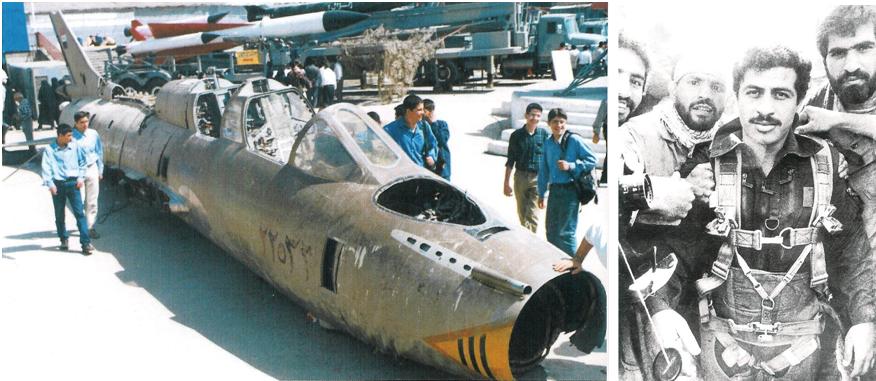
Combat Aircraft 37: Iranian F-4 Phantom II Units in Combat
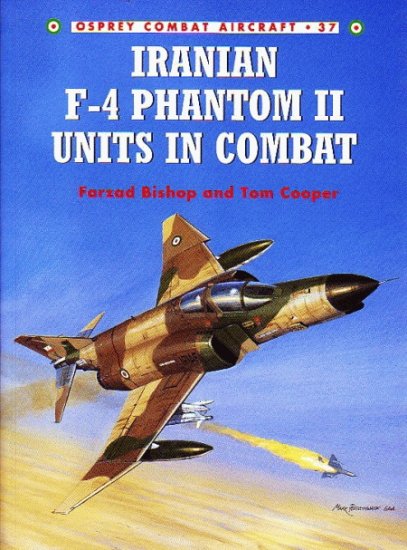 Title: Iranian F-4 Phantom II Units in Combat (Combat Aircraft 37)
Title: Iranian F-4 Phantom II Units in Combat (Combat Aircraft 37)Combat Aircraft 49: Iranian F-14 Tomcat Units in Combat
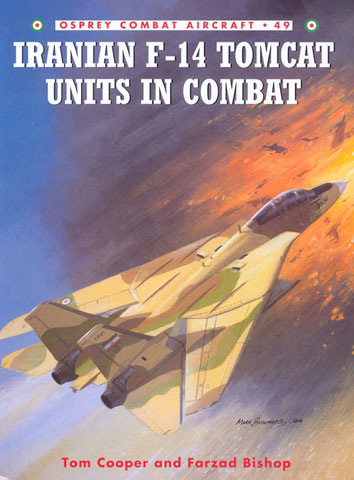 Title: Iranian F-14 Tomcat Units in Combat (Combat Aurcraft 49)
Title: Iranian F-14 Tomcat Units in Combat (Combat Aurcraft 49)